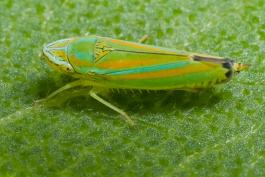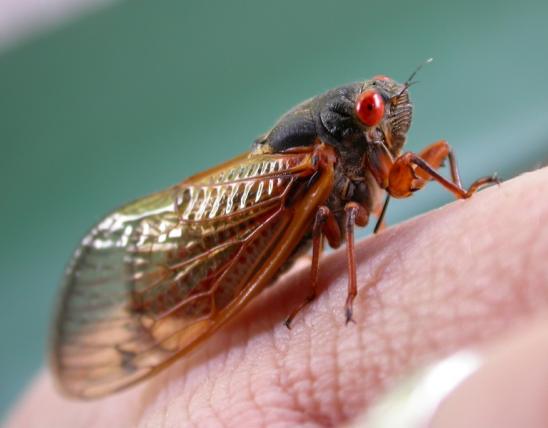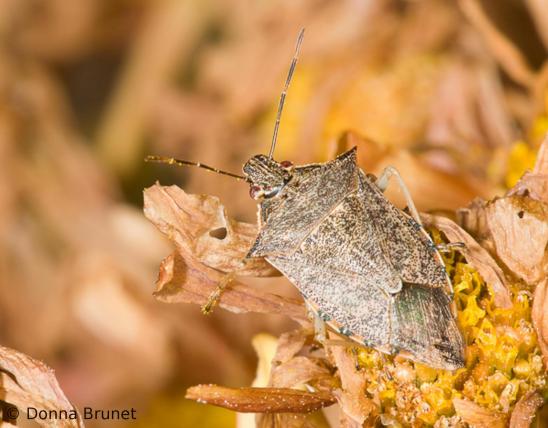
The leafhoppers are a large and diverse family of sap-sucking, hopping insects. In overall body form, many look a lot like cicadas — only much smaller! You can distinguish them from similar groups of small hoppers by the hind legs, which have 1 or more rows of small spines on the hind tibiae (“shins”). Their bodies tend to be parallel-sided or taper toward the rear. The bulbous base of each thin, bristle-like antenna is relatively short (compared to that of planthoppers). There are 2 ocelli (small, simple eyes) atop the head (usually between the 2 compound eyes.
Leafhoppers may possess dull, camouflage colors or they may be breathtakingly vivid. Many species are gray, brown, tan, black, or various shades of green or ocher, but some (especially in subfamily Cicadellinae, the “sharpshooters”) sport racy striped patterns of robin’s-egg blue and red, or chartreuse and deep orange, maroon and yellow, chartreuse and baby blue, or black and sky blue.
Even the species with relatively drab colorations frequently possess intricately beautiful markings, resembling the swirls of agate or the patterns on moth wings. Some species have bold patches of contrasting colors.
Unique among insects, leafhoppers excrete a substance containing microscopically small, waxlike granules called brochosomes. Using the comblike rows of spines on their hind legs, leafhoppers rub this material over their bodies (scientists call this behavior “anointing”). Functionally, it is about the same as waxing a car: it protects the outer cuticle of the insect from water and from the sugary excretions from fellow sap-drinking insects.
Females of several leafhopper species wipe and clump the brochosomes into an oval patch or a line about midway along each wing. They use this white material in the egg-laying process (see Life Cycle, below). So be advised that a white patch or line on the side of a leafhopper may not be useful for species identification, since it’s not actually a body color.
Because they are a very large and diverse group, leafhoppers may best be identified by determining that they are not treehoppers, planthoppers, or spittlebugs/froghoppers:
- Spittlebugs and froghoppers are a lot like leafhoppers but have only 1 or 2 stout spines on the hind tibiae (“shins”), plus a small ring of spines at the outer tip of that leg segment. Many species’ bodies are widest at the hind end (a little like a resting frog, hence the name “froghopper”). Larvae live in bubble shelters on plant stems.
- Planthoppers often have angled or pointed heads. The antennae are attached below the eyes, on the sides of the head (“cheeks”). The two basal segments of each antenna are thick or bulbous (comparatively large) beneath the outer segment that is a thin bristle. The wings may be large, or they may be barely long enough to cover the first few segments of the abdomen.
- Treehoppers have an enlarged pronotum (shieldlike part just behind the head) that extends backward to cover the abdomen; often it is shaped to resemble a thorn or twig-bark wart.
Length: Most species are less than about ½ inch (13 mm); some may reach 1¼ inches.
Statewide. Different species may be associated with different types of plants, so their distributions may vary across the state.
Habitat and Conservation
Leafhoppers may be found nearly anywhere, because they live wherever plants grow. Many species are associated with only certain types of plants, while others may eat a wide variety of plants.
Food
Like other hoppers, leafhoppers have their mouthparts arranged into a tube, which they insert into a plant leaf or stem and then use to suck plant fluids.
Life Cycle
Like most other related hoppers, female leafhoppers use a hollow, needle-like structure called an ovipositor to poke a hole into the leaf or stem of a suitable host plant and insert eggs into the living plant tissue. When the eggs hatch, the nymphs (juvenile leafhoppers) eat and grow, molting 5 times. The final molt renders them winged, sexually mature adults.
Females of several leafhopper species rub and pack the brochosomes into a white patch or line about midway along each wing. After inserting their eggs into a plant stem, the female dabs some of this material onto the hole, which prevents the eggs from drying.
Some leafhopper species are migratory, moving north in the spring and south in the fall.
Human Connections
Some of the species in this family are serious crop pests, causing damage by their feeding and/or egg-laying, but sometimes also by transmitting plant diseases.
- The nonnative beet leafhopper (Neoaliturus tenellus), introduced to our continent from Asia, carries the beet curly top virus from plant to plant. The disease damages plants in the potato or nightshade family, including chilis, eggplant, tobacco, and tomato.
- The potato leafhopper (Empoasca fabae), by its piercing-and-sucking feeding ecology, causes “hopperburn,” a mechanical injury to a wide range of crop plants, especially legumes, potato, fruits, and vegetables. This species can’t survive cold winters but must migrate north each spring. Scientists are concerned that climate change may cause their range to shift northward, worsening their impact in more of our continent.
- The glassy-winged sharpshooter (Homalodisca vitripennis) damages grapes, citrus, and a variety of stone fruit trees. They are a vector (transmitter) of a bacterium associated with leaf-scorches and other plant diseases.
The vast majority of leafhoppers are not pests. The red-banded (or candystriped) leafhopper (Graphocephala coccinea), and many other species of gorgeous, brilliantly colored leafhoppers will reward you for paying attention to insects that may only be ¼ inch long.
Ecosystem Connections
In 1987, the famous scientist and champion of nature E. O. Wilson gave an address called “The Little Things That Run the World.” He argued that even though we’re more accustomed to caring about birds, fish, and mammals, people need to work to protect invertebrates from extinction. “If invertebrates were to disappear, I doubt that the human species could last more than a few months. Most of the fishes, amphibians, birds, and mammals would crash to extinction about the same time. Next would go the bulk of the flowering plants and with them . . . the forests and other terrestrial habitats of the world.”
The biological field of “plant-insect interactions” is unendingly rich and interesting, covering not only the topics of crop pests but also the intricate connections between the thousands of insect species whose destinies are bound with their individual host plants.
As with aphids, planthoppers, treehoppers, and other sap-drinkers, the excretions of leafhoppers are relatively watery and have a high sugar content, and many species have mutually beneficial relationships with ants. The ants receive the sugary fluid (called “honeydew”) and complement the hoppers by guarding them from insect predators and parasites.































